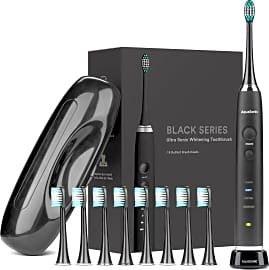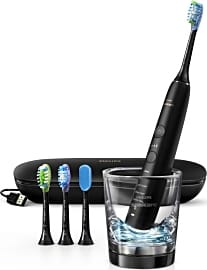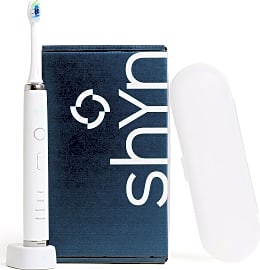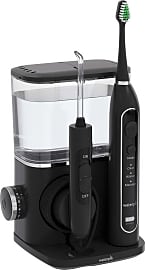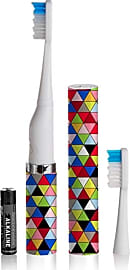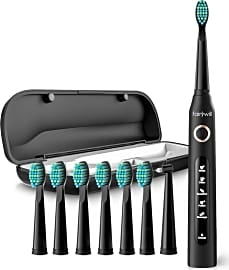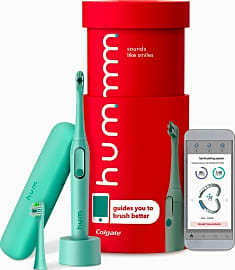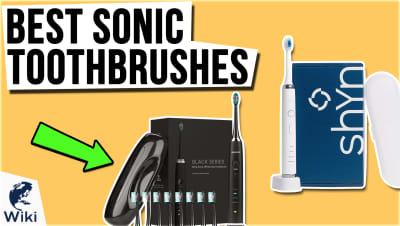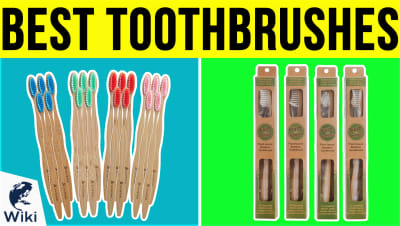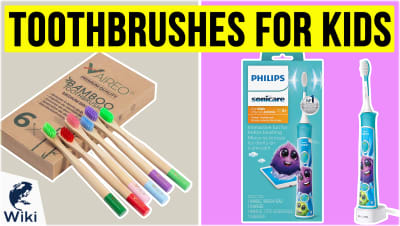The 10 Best Electric Toothbrushes

This wiki has been updated 39 times since it was first published in October of 2015. If you want that just-left-the-dentist feeling every day, try one of these sonic toothbrushes. They work much better than manual models to remove stains and keep your pearly whites looking their best. These devices remove plaque and bacteria effectively to prevent gingivitis and bleeding gums, and good oral health is now believed to contribute to overall bodily health. When users buy our independently chosen editorial selections, we may earn commissions to help fund the Wiki.
Editor's Notes
November 28, 2020:
When it comes to oral health, sonic toothbrushes are more effective than their manual counterparts. However, a 2017 study found that these powered devices can eat away at the tissue below the tooth's enamel if used for more than the recommended two minutes. Other factors like the number of brush strokes per minute, the amount of pressure used, and the stiffness of the bristles also played a part.
As one of the first brands to use sonic wave technology, the Philips Sonicare brand has a long track record of improving oral health. Still, we removed the Philips Sonicare HX5611/01 Essence from the list because it lacks the power of other models. We also removed the Pyle Health Sonic Wave. Not only did customers express frustration with trying to find replacement heads, but some users also complained about the bristles falling out while brushing.
This list was updated to include the Shyn Rechargeable and the Colgate Hum. Besides doing a great job of removing plaque and tartar, each model has advanced features to simplify the brushing experience. The former has a built-in sensor to prevent users from brushing too hard, which can cause the gums to bleed and the latter can be paired with an app to point out which areas of the mouth need attention.
December 09, 2019:
A sonic toothbrush is similar to a standard electric toothbrush, but it's capable of producing more intense vibrations. This makes it great for removing stubborn plaque and, in turn, improving the health of your mouth and reducing your time spent in a dentist’s chair. This update brings in several new and updated models – some of which even come with corresponding smartphone apps that can assess how well you’re brushing – like the Philips Sonicare DiamondClean.
The Philips Sonicare ProtectiveClean 4100 produces an impressive 31,000 vibrations per minute, which makes it seven times more effective at removing plaque and debris than a manual toothbrush. It comes with some handy bells and whistles, including lights and sounds that alert you at times when you’re applying too much brushing pressure, or when it’s time to replace the head. From the same manufacturer, the Philips Sonicare Essence is thoughtfully designed with a startup mode that gradually increases in intensity over the first 12 times you use it, to help you get used to its operation.
From another well-known name in electronic tooth care devices, the Waterpik Complete Care 9.0 joins the selection as an option that provides tools for both brushing and flossing. It’s equipped with five water flosser tips, 2 brush heads, and a sturdy travel case. You can buy it with confidence, thanks to its 2-year warranty.
The newly added AquaSonic Black may be a lesser-known model, but it’s a force to be reckoned with, as far as both quality and price. Like many others, this one is waterproof, and it’s packed with high-tech and useful features like ultra-fast wireless charging, bright LED indicator lights, a lithium ion battery, and the ability to deliver 40,000 vibrations per minute. It offers modes for cleaning, whitening, massaging, and a gentle one for those with sensitive teeth and gums.
Special Honors
Goby Electric Toothbrush This brush’s soft, premium bristles oscillate gently, yet thoroughly, for a clean and fresh mouth. It’s equipped with a normal speed setting as well as a sensitive one, along with a long-lasting battery. It sits in its sturdy base when not in use and is equipped with a USB charging shell and adapter, as well as a brush head cover, for convenient use when you’re on the go. Choose from among no-nonsense black and white, or eye-catching models in iridescent, rose, blue, and gold. While it might not rotate quickly enough to be considered a true sonic model, it’s designed to make the most of your brushing time and is registered with the FDA as a Class 1 device. goby.co
Burst Sonic Toothbrush The Burst Sonic Toothbrush runs for a month on a single charge. Its nylon bristles are infused with plaque removing charcoal, but the bristles tend to be too soft for some users. Besides, massage and whitening settings, it features a sensitive mode to reduce pressure while brushing. Plus, it features a two-minute timer and a 30-second reminder. burstoralcare.com
A Brief History Of The Toothbrush
Other tooth-picking utensils, like feathers, animal bones, and porcupine quills, were also popular in various regions throughout history.
While there have been plenty of advancements in dental care over the past few decades, generally speaking, the toothbrushes we use today are not so different from the models used 100 years ago. To understand the history of the toothbrush, it's important to talk about what came before it.
The toothbrush's main predecessor is called the chew stick. It usually consists of a twig, one side of which can be used as a toothpick. The other end is frayed to form a brush-like device. While it dates back to at least 3500 B.C. E. in the Middle East, it is still popular today in many parts of the world. Other tooth-picking utensils, like feathers, animal bones, and porcupine quills, were also popular in various regions throughout history. A soot and salt-soaked rag was also a popular cleaning method in 1700s Europe.
The bristle-headed brushes we use today are based on implements developed in China's Tang Dynasty, sometime in the latter half of the first millennium. They used hairs from hogs in northern China and Siberia, preferred for their stiffness. Their handles were typically made from bamboo or animal bone. Through trade and travel expeditions, the toothbrush made its way to other parts of Asia and eventually to Europe, where it gained popularity in the late 1600s. Horse hair became a popular alternative to boar and hog bristles because it offered a more gentle brushing experience.
Mass-produced brushes came to the market in the United Kingdom in 1780, spawning the Wisdom Toothbrushes company, which still exists today. An American version was patented in 1857, though production on this continent did not begin at a large scale until 1885.
By the turn of the 20th century, synthetic materials began replacing the animal bones and bristles used in many models. Celluloid was widely used for handles, while bristles made of nylon fibers reached the mass market in 1938. The first electric model was introduced in Switzerland in 1954, intended for those with inhibited motor skills. General Electric developed a batter-powered version about a decade later. The sonic brush arrived in 1992.
Today, standard, electric, and sonic brushes all remain popular. While the latter type is typically rechargeable and comes with a replaceable head, requiring only a one-time purchase of the base unit, most other brushes are cheap and disposable. The latest advancements in toothbrush technology include pressure sensors to keep you from brushing too hard, Bluetooth connectivity to track your brushing data, and brushes with adjustable cleaning modes to maximize efficacy in every part of your mouth.
How Sonic Toothbrush Technology Actually Works
The basic principle behind sonic toothbrushes is vibration. While you scrub your gums, molars, and tongue with a traditional brush, the physical action clears particles and debris manually. Sonic brushes emit a high-frequency sound wave, and its vibrations help break down bacteria and dislodge dental plaque. The brush head does not actually need to make contact with the plaque in order for this effect to work, it just needs to be close enough that the sound waves reach the tooth's surface. The term sonic refers to these sound waves.
The vibrations themselves are usually produced by applying an electric charge to a piezoelectric crystal in the brush's base.
The dual action of sonic brushes makes them more effective than their manual cousins. While standard electric brushes have some of the same effects, their vibrational frequency is usually much lower than sonic or ultrasonic models, which makes them less powerful at removing plaque, especially when it is out of reach. Some sonic brushes are powerful enough to remove plaque that sits on a tooth's surface below the gum line.
The difference between electric and sonic toothbrushes has to do with the intensity of vibration. Standard electric brushes, for example, typically perform 10,000 to 12,000 movements per minute. Sonic brushes are classified as such because their frequencies usually fall within the audible spectrum, which ranges up to 2.4 million movements per minute. Brushes on the higher end of this range, as well as those that exceed it, are usually marketed as ultrasonic. The most common frequency used in ultrasonic brushes is 1.6 megahertz, which falls well beyond the audible range, and consists of 192 million movements per minute.
The vibrations themselves are usually produced by applying an electric charge to a piezoelectric crystal in the brush's base. Piezoelectric substances can convert electric signals to mechanical ones and vice versa, and are also used in microphones, record players, headphones, analog clocks, and even cigarette lighters.
A Few Notes On Ensuring Your Dental Health
While it may seem ubiquitous now, regular brushing was not commonplace in the United States until after World War II, during which soldiers were required to clean their teeth every day. That being said, the practice is now instilled in the minds of Americans and much of the industrialized world as a necessity as soon as we develop cognizance. In 2003, for example, an MIT study revealed that the toothbrush was the number one invention Americans said they could not live without, beating out the computer, cell phone, and automobile.
A good dental hygiene routine demands more than just brushing, however.
Many dentists recommend brushing your teeth for at least 60 seconds twice a day. A good dental hygiene routine demands more than just brushing, however. The importance of flossing is difficult to understate, for example. Flossing can help you reach the surfaces between your teeth that the bristles of your toothbrush tend to miss. Every tooth has five exposed surfaces where food particles and plaque can build up, and your tooth-cleaning regimen should address each of them. If you skip flossing altogether, you're only hitting 60 percent of the surfaces of your teeth.
Another important ingredient in your oral routine is toothpaste. The manual (and vibrational, if you're using a sonic model) effects of brushing help clear your mouth of any particles stuck to your teeth. But a brush without a good toothpaste can only do so much. It's essential to use a toothpaste that helps strengthen teeth with ingredients like fluoride, which can help prevent cavities and ensure the long-term health of your molars.




